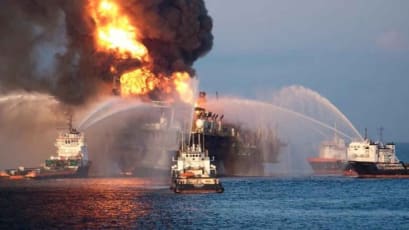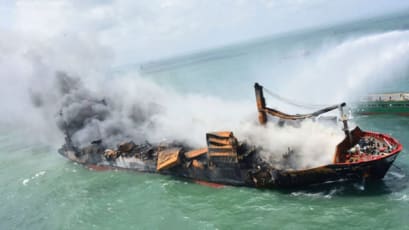Montara West Atlas: coordinating a Tier 3 spill response in the Timor Sea
Over 74 days, the Montara West Atlas incident released 30,000 barrels of crude oil into the Timor Sea, followed by a challenging offshore multi-agency spill response operation.
Background
On 21st August 2009, the Montara Wellhead Platform in the Timor Sea, operated by PTTEP Australasia, experienced a well control incident during the drilling of a relief well. The blowout resulted in an uncontrolled flow of oil and gas, with hydrocarbons reaching the sea surface. Over the course of 74 days, an estimated 4.9 million litres of oil were released into the marine environment, spreading across a wide area and threatening sensitive ecosystems, fishing grounds, and tourism-dependent communities in neighbouring regions. The incident marked one of Australia’s most significant environmental crises.
Response activation
The Australian Maritime Safety Authority (AMSA) led the national response, deploying aerial dispersants and monitoring the spill trajectory. Due to the remote location and prolonged nature of the incident, response efforts faced logistical and operational challenges.
The incident was classified as a Tier 3 event, requiring international support to mitigate its impact effectively.
The context behind OSRL’s involvement
OSRL was iniitally mobilised by an Australian Response Organisation. This was due to the close relationship we held with this particular stakeholder. This relationship facilitated the mobilisation of equipment and personnel at an early stage, allowing the responsible party to focus on the well kill operation.
OSRL was engaged to provide expert guidance and operational support, helping coordinate a multi-agency response.
We deployed a team of technical advisors and equipment to the site, working alongside local authorities and PTTEP Australasia’s Incident Management Team. Our contributions focused on containment, recovery, and shoreline protection, ensuring alignment with global good practices.

Main goals and priorities
- Minimise impact on marine and coastal ecosystems
- Minimise disruption to local communities and industries
- Ensure the safety of responders and stakeholders
- Restore affected areas to pre-spill conditions
Unique challenges
- Remote location: The spill site’s distance from mainland facilities – 140 nautical miles (260 kilometres) offshore - complicated logistics and resource deployment.
- Prolonged operations: Sustaining response efforts over 74 days required extensive coordination and resource management.
- Environmental sensitivities: Protecting sensitive marine ecosystems such as coral reefs demanded precision and adaptive strategies.
- Cross-border concerns: Transboundary oil movement necessitated cooperation with neighbouring countries.

Incident timeline
- 21 August 2009: Blowout occurs at Montara Wellhead Platform, initiating the spill.
- 22-23 August 2009: Initial assessment and containment efforts commence.
- 26 August 2009: PTTEP Australasia activates Tier 3 response protocols, requesting international support.
- 28 August 2009: OSRL deploys technical advisors and equipment to the site.
- 3 November 2009: Successful well kill, the spill is officially declared contained after 74 days of efforts.

Solution
- Multi-agency collaboration: A total of 247 response personnel were activated, with many undertaking several rotations. This was only possible through the joint efforts of OSRL, oil industry operators, the Australian Response Organisations, the National Response Team, and assistance from all States, Northern Territory and New Zealand.
- Surveillance and predictive modelling: Over 130 surveillance flights were conducted throughout the operation. Real-time data collection allowed the integration of modelling tools to predict oil movements and impacted zones.
- The right equipment: In accordance with the Australian National Plan, OSRL deployed aerial dispersant systems using the aircraft Hercules C-130 (based in Singapore) to combat areas with heavy concentration of oil. All six types of dispersants used (Slickgone NS, Slickgone LTSW, Ardorx 6120, Tergo R40, Corexit 9500, Corexit 9527) were lab tested for toxicity levels and pre-approved for use. Teams onsite continuously tested dispersant effectiveness using Fluorometry. The use of dispersant was highly effective in assisting the natural process of biodegradation.
- Shoreline protection: Oil sheen and weathered oil were observed travelling in all directions due to currents and wind. Teams implemented manual and mechanical recovery techniques to help protect sensitive habitats, including coral reefs and migratory paths.
Results
After months of coordinated efforts, the Montara response achieved significant milestones. The oil spill was successfully contained and further environmental damage was prevented. Follow up operations worked towards the restoration of affected areas through targeted clean-up operations. The collective engagement of local and international organisations strengthened regional capacity for future incident management.
Key learnings
The Montara West Atlas oil spill provided critical insights into effective spill response:
- Proactive preparedness: Comprehensive contingency planning and training are essential for addressing complex incidents.
- Early mobilisation: Rapid deployment of resources and expertise enhances response efficiency.
- Collaborative efforts: Strong partnerships among agencies, operators, and response organisations ensure alignment and shared accountability.
- Innovation and adaptation: Leveraging advanced technologies and flexible strategies is crucial in dynamic scenarios.
Why choose OSRL
With decades of experience and a global team of experts, we provide proven solutions tailored to diverse challenges. Our extensive inventory of specialised equipment enables swift and effective responses to spills of all magnitudes. We collaborate with local organisations and regulatory bodies worldwide, ensuring seamless integration and alignment in response operations. By leveraging the latest advancements in spill response, we continuously enhance our methods and capabilities to address evolving environmental and industry needs.
Want to talk about spill response?
OSRL offers a holistic approach to response, with solutions for offshore, inland and subsea incidents. Our teams are trained to operate in all environments—from remote regions to extreme cold—and bring specialised capability to all aspects of spill response, including areas like oiled wildlife that require specific expertise. Our Members get access to technical advisors, our Global Dispersant Stockpile, aviation services, and equipment hire solutions.
Find out more about our Membership options.







